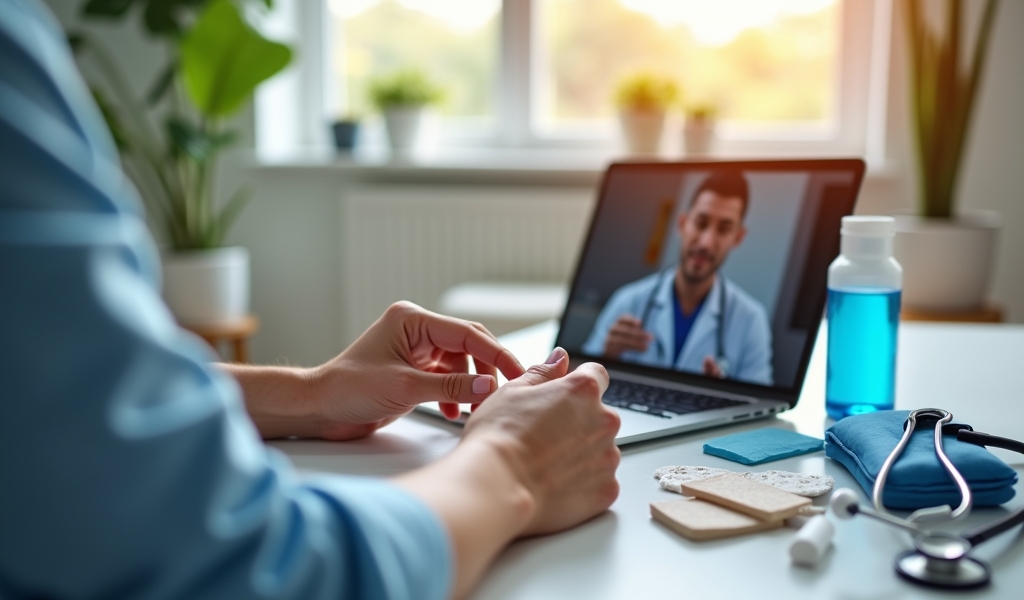Overview
Abrasions are superficial skin wounds that require proper home treatment to prevent complications and promote healing, with the article outlining five key steps: cleaning the wound, controlling bleeding, applying appropriate products, proper bandaging, and monitoring healing progress. These steps, along with additional care tips for pain management, nutrition, and scar prevention, can help most minor abrasions heal quickly without medical intervention, though signs of infection or complications should prompt professional care.
Table of Contents
- Introduction
- Step 1: Clean the Wound Properly
- Step 2: Control Bleeding and Apply Appropriate Pressure
- Step 3: Apply the Right Wound Care Products
- Step 4: Proper Bandaging Techniques
- Step 5: Monitor for Proper Healing
- Additional Care Tips
- Conclusion
- Frequently Asked Questions
Abrasions happen to everyone – a scraped knee after a fall, a brushed elbow from a bicycle accident, or a skinned palm from a stumble on rough pavement. These superficial wounds, which damage the top layers of skin, might seem minor but require proper care to heal quickly and prevent complications. Fortunately, most abrasions can be treated effectively at home with the right knowledge and supplies. In this guide, we’ll walk through five proven steps for online treatment for abrasions, helping you heal faster while minimizing discomfort and reducing infection risk.
Introduction
Abrasions occur when skin rubs or scrapes against a rough surface, removing the protective outer layers and exposing sensitive underlying tissue. Unlike cuts, which result from sharp objects creating clean wounds, abrasions typically cover a broader area and have an irregular, scraped appearance. Common causes include falls on rough surfaces, sports injuries, bicycle accidents, and friction burns.
Proper treatment matters significantly – untreated abrasions risk infection, delayed healing, and potentially permanent scarring. With online treatment for abrasions guidance, most people can confidently treat these injuries at home, saving time and unnecessary medical visits for minor cases.
At Dr. Telx, we understand that abrasions can be painful and concerning, which is why our healthcare professionals are available for virtual consultations should you need personalized guidance on wound care.

Step 1: Clean the Wound Properly
The first and most crucial step in online treatment for abrasions is thorough cleaning. This removes dirt, debris, and bacteria that could cause infection or get trapped under healing skin.
Begin by washing your hands thoroughly with soap and water. Then, gently rinse the abrasion under clean, lukewarm running water for 5-10 minutes. Use mild, unscented soap around (not directly on) the wound area to cleanse the surrounding skin. For abrasions with visible debris, use clean tweezers sterilized with alcohol to carefully remove particles.
For cleaning solutions, sterile saline is ideal as it’s gentle on damaged tissue. If unavailable, clean tap water is effective for most situations. Avoid hydrogen peroxide, alcohol, or iodine directly on abrasions as these can damage healthy tissue and delay healing, according to research from the American Academy of Family Physicians.
Step 2: Control Bleeding and Apply Appropriate Pressure
Most abrasions bleed minimally since they primarily affect superficial skin layers. However, some deeper abrasions may produce more significant bleeding that requires attention.
To control bleeding, apply gentle, steady pressure using a clean cloth or gauze pad. Maintain pressure for 5-10 minutes without constantly checking, as this disrupts clot formation. Elevating the injured area above heart level can also help slow bleeding.
If an abrasion continues bleeding heavily after 15-20 minutes of direct pressure, or if blood appears to be pulsing from the wound, seek immediate medical attention as this suggests a deeper injury requiring professional care.
Normal abrasion bleeding typically stops within 10 minutes. Any bleeding beyond this timeframe might indicate a more severe wound or could be affected by blood-thinning medications.
Step 3: Apply the Right Wound Care Products
Once cleaned and with bleeding controlled, applying appropriate products supports healing and prevents infection in the online treatment for abrasions process.
For most abrasions, a thin layer of petroleum jelly (like Vaseline) provides an optimal healing environment. It keeps the wound moist, prevents scab formation, and allows new skin cells to migrate across the wound surface more easily. Despite popular belief, antibiotic ointments like Neosporin aren’t necessary for all abrasions and can sometimes cause allergic reactions.
Modern wound dressings like hydrocolloid bandages create an ideal healing environment by maintaining moisture while absorbing excess fluid. These are particularly useful for larger abrasions or those in high-movement areas.
Avoid products containing alcohol, fragrance, or multiple antibiotics, which can irritate damaged skin and potentially delay healing.
Step 4: Proper Bandaging Techniques
Covering abrasions protects them from contaminants and further injury while creating an optimal healing environment.
For standard bandaging, first apply a non-stick pad (like Telfa) directly over the abrasion after applying petroleum jelly. Secure this with paper tape, stretch gauze, or an adhesive bandage appropriate for the location. Ensure the bandage isn’t too tight – it should protect without restricting blood flow.
For joint areas like knees and elbows, use flexible fabric bandages or butterfly-shaped adhesive bandages that accommodate movement. For fingers, tube gauze or finger cots work well.
Change bandages daily or whenever they become wet or soiled. When healing progresses and the wound begins forming new skin (typically after 2-3 days), you may leave smaller abrasions uncovered during the day but protected at night.
A properly bandaged abrasion feels comfortable and shows decreased redness and drainage within 24-48 hours.

Step 5: Monitor for Proper Healing
Monitoring healing progress helps ensure recovery is on track and allows early identification of potential complications.
Most superficial abrasions heal within 5-7 days, while deeper ones may take 1-2 weeks. During normal healing, you’ll notice:
- Decreased redness and swelling after 2-3 days
- Gradual formation of new pink skin
- Reduced pain and tenderness
- Minimal clear or slightly yellow drainage initially, decreasing over days
Warning signs that warrant professional attention include:
- Increasing redness, warmth, or swelling beyond the wound edges
- Red streaks extending from the wound
- Throbbing pain that worsens after 48 hours
- Thick, cloudy, or foul-smelling drainage
- Fever or generally feeling unwell
- No signs of healing after one week
At Dr. Telx, our virtual doctor visit providers can assess your healing progress through secure video visits if you’re concerned about how your abrasion is healing.
Additional Care Tips
Beyond the five core steps of online treatment for abrasions, several additional practices can optimize healing:
For pain management, over-the-counter pain relievers like acetaminophen or ibuprofen can help manage discomfort. Cold compresses applied for 15-20 minutes several times during the first 24 hours can reduce pain and swelling.
Nutrition plays a vital role in wound healing. Ensure adequate protein intake and consume foods rich in vitamin C (citrus, berries), zinc (nuts, seeds), and vitamin A (orange vegetables, leafy greens) to support tissue repair, as supported by research published in the Journal of Clinical Medicine.
Protect healing abrasions during daily activities by covering them with appropriate bandages during exercise or when exposed to dirt or water. For showering, waterproof bandages or plastic covers can keep the area dry.
To minimize scarring, continue using petroleum jelly even as the abrasion heals, and protect the area from sun exposure for at least six months, as new skin is highly susceptible to UV damage.
Conclusion
Effective online treatment for abrasions requires a systematic approach focused on cleaning, bleeding control, appropriate product application, proper bandaging, and vigilant monitoring. By following these five proven steps, most abrasions will heal quickly with minimal complications.
Remember that while minor abrasions can be managed at home, more serious wounds – particularly those that are deep, highly contaminated, or showing signs of infection – require professional medical attention. Additionally, individuals with diabetes, compromised immune systems, or taking blood thinners should consult healthcare providers about even seemingly minor abrasions.
At Dr. Telx, we’re committed to supporting your health journey with accessible virtual care options. Our doctor on demand professionals can provide personalized guidance for wound assessment and treatment through convenient telehealth appointments.
Frequently Asked Questions
Should I let my abrasion “air out” or keep it covered as part of online treatment for abrasions?
Modern wound care science clearly shows that moist, covered wounds heal faster with less scarring than dry, uncovered ones. Keep abrasions covered with petroleum jelly and an appropriate bandage until new skin forms.
How can I tell if my abrasion is infected?
Infection signs include increasing pain, swelling, and redness beyond 48 hours; red streaking from the wound; pus-like drainage; warmth around the wound area; and fever. If you notice these symptoms, seek medical attention promptly.
Do I need a tetanus shot for an abrasion?
If your abrasion occurred in a dirty environment and it’s been more than 5 years since your last tetanus booster, consult with a healthcare provider about getting updated protection.
Can I swim with an abrasion?
It’s best to avoid swimming in pools, lakes, or oceans until your abrasion has formed new skin (typically 3-5 days). Chlorine can irritate wounds, and natural bodies of water contain bacteria that could cause infection.
When should I seek professional medical care for an abrasion?
Seek medical care if: the abrasion is very deep or large; you can’t remove all debris; bleeding doesn’t stop with pressure; signs of infection develop; the wound is on your face (potential scarring); or if you have underlying conditions like diabetes or immunosuppression.

